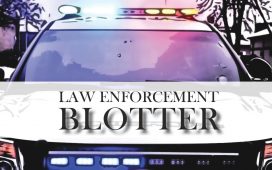Photo by Howard Owens
Anyone who has walked or cycled down a city street may have experienced some trepidation when dealing with automobile traffic on major routes and wished there were more options for pedestrians and bicyclists to get from home to shopping, recreation, work and appointments.
City management is hoping to do just that with a citywide transportation study, with the eventual goal of improving transportation options and safety for people who use modes of transportation other than motorized vehicles.
City Council has tentatively approved the study for $80,000, which will be paid for with a $70,000 federal grant and $10,000 from the city, and City Manager Rachael Tabelski briefed council members about the study during this week’s conference session.
“The corridors we’ve identified that we really want to focus on include downtown Batavia, the Uptown Connection, which would be connecting transportation options from downtown to the Harvester campus, the Healthy Living triangle that connects the McCarthy Ice Arena, Austin Park and Ellicott Trail with the newly constructed Healthy Living campus, improving the Ellicott Street corridor — that’s one of our main focuses of the study is to look at the traffic in that corridor and look at any type of traffic calming measures that help it help pedestrians and bicyclists feel safer in the Ellicott Street corridor — the West Side commercial corridor, and then parks and recreation areas and how they connect to neighborhoods,” Tabelski said. “So those would be the goals and the focus of the study. Once the study is done, you can then apply for grant funds using the study in the future.”
The city has been awarded a $70,000 grant from the Genesee Transportation Council. It will match the funding with $10,000 of committed funds and establish a steering committee to work with a consultant to complete the project.
The study will identify opportunities for enhanced connectivity between neighborhoods, reduce reliance on single-occupancy vehicles, and ensure that all residents, including those in underserved areas, have access to safe and efficient active transportation options, according to the plan. It will also aim to bolster the use of non-motorized transportation, such as walking, cycling, and multi-modal transportation options, which align with the goals of the city’s 2017 Comprehensive Plan.
The city has already made progress on improving pedestrian and bicycle infrastructure through various initiatives, Tabelski said, including the Transportation Enhancements/Alternatives Program, Healthy Schools Corridor, approximately $5 million in sidewalk investments over the past decade, and the creation of the Ellicott Trail that winds throughout the city. However, officials believe there remains a need to identify and implement further improvements to create a more connected and accessible transportation network and a healthy living corridor.
Once the final plan is adopted, it should provide a framework that will help the city achieve the following:
Create a citywide transportation plan as a guide for implementing and enhancing safety, access, and connectivity for all modes of transportation.
Provide opportunities to promote healthier, more active lifestyles for city residents by improving mobility and connections to jobs, shopping, and recreation in the downtown area, focusing on the “Healthy Living Triangle.”
Improve access to the South side of Batavia through improvements to the Ellicott Street corridor, including pedestrian and bicycle infrastructure.
Connecting downtown, Ellicott Street/Ellicott Trail and the Uptown corridor (Harvester Street and Swan Street) will improve walkability, access to businesses, arts and culture, and create a feeling of safety for pedestrians and bicyclists.
Reduce the risk of traffic accidents on major routes within the city.
There are several projects underway that will have an impact on transportation in Batavia, city management says, including:
Ellicott Street Corridor — a key route through Batavia that connects Routes 63 and 5 — had a major overhaul several years ago to make it a two-lane highway for trucker traffic and seemed to hamper much of the traffic entering from side streets, is in need of improvement to better connect neighborhoods, key destinations, and the growing pedestrian and cyclist traffic.
Ellicott Trail, a multi-use path that runs through the corridor, requires upgrades to enhance safety and accessibility for non-motorized users. Additional housing developments and mixed-use projects have added affordable and market-rate housing units, increasing pedestrian and bike traffic. With 38% of traffic consisting of light trucks and an active rail line crossing near downtown, the corridor faces significant challenges.
Planned upgrades will focus on improving traffic flow, ensuring pedestrian and cyclist safety, reducing speed, exploring traffic-calming measures, improving crossings, and improving signage.
Environmental Justice and equity: the city is home to several environmental justice block groups, and the demographic composition underscores the importance of making the transportation system more accessible, inclusive and safe for all residents, especially the Ellicott Street Corridor. The transportation plan will focus on addressing the needs of these vulnerable populations, ensuring that improvements benefit all residents, particularly those in underserved communities.
Downtown/Uptown Connection: In 2017, the city began advancing downtown revitalization projects to stimulate economic growth and revitalize its downtown. To date, it has resulted in $65 million in improvements. These grant-funded improvements have enhanced the downtown, improving connectivity for residents, supporting multimodal transportation between downtown, the uptown connection of Harvester Avenue and surrounding residential neighborhoods, helping to sustain economic momentum.
Zoning code update: For the first time in more than two decades, the city is reevaluating and comprehensively updating its city code. The code update will be comprehensive, user-friendly, pro-economic development and simple to read.
The mandatory task is to form a project steering/advisory committee by identifying all applicable stakeholders, such as state transportation facilities and other infrastructure (road, bridge, bike or pedestrian facilities or transit). If stakeholders are not part of the committee, they must have the opportunity to review and comment on draft recommendations that impact their facilities.
Other tasks include publicly announcing a request for proposals, and a designated group will evaluate the responses and hire a consultant with specialized experience in active transportation planning; having the consultant collaborate with the committee, which may include representatives from the Genesee County Planning Department, town of Batavia, Batavia Development Corp., Batavia Improvement District, Genesee Community College, Chamber of Commerce, City Council, Genesee County Economic Development Center, Batavia Police Department, local business owners, GTC staff, Regional Transit Service and Office for the Aging. These entities will assist by providing relevant data, reviewing project tasks and evaluating feasible options.
The consultant is to perform an analysis of current conditions and assess the needs of the project area, including the city’s background, historical context, planning documents, existing land use, ownership and zoning regulations; a comparison of the findings to the goals and priorities outlined in the city’s strategic plan, ensuring alignment with the vision for the community’s future development, including integration of complete street and traffic calming elements where applicable; analyzing motor vehicle traffic patterns, identifying physical and program needs; and engaging the public through meetings, surveys, stakeholder interviews and/or focus groups.
The committee and consultant will collaborate to identify opportunities to enhance active transportation throughout the city based on the needs previously identified and eventually recommend improvements to multi-modal circulation and access throughout the area, in preparation for a final report that summarizes the key findings and recommendations.
Public participation is crucial to the study, and the consultant plans are to include and engage low-income, minority, disabled, senior and youth populations. Two public meetings will be scheduled to gather input on existing conditions, needs and goals and to then present draft findings and recommendations and obtain feedback before finalizing the study.
A tentative schedule has been set to begin with November for scope of work approval, an RFP release in January 2025, selection of the consultant and City Council approval in March, a signed contract by April, a kickoff meeting in May, existing conditions analysis and needs assessment finalized by August, concept plans, strategies and recommendations finalized by October, a draft final report by the end of 2025, and a completed study by February 2026.
Photo by Howard Owens









